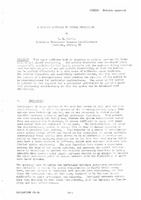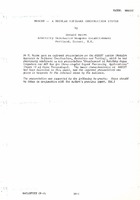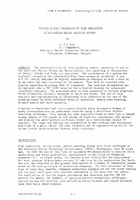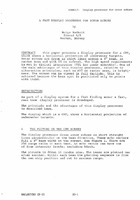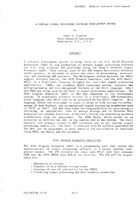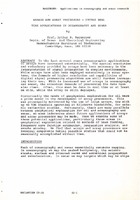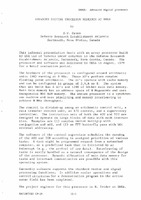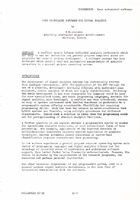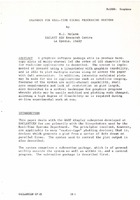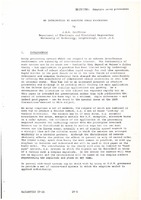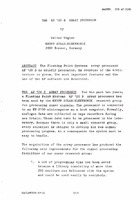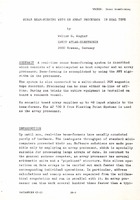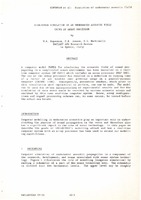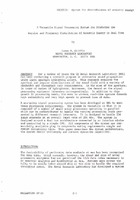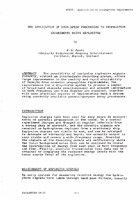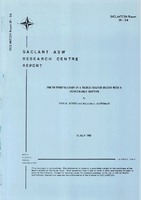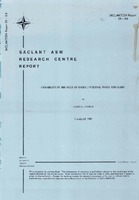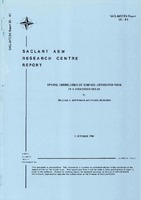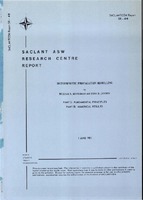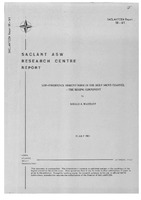Browsing Reprints by Issue Date
Now showing items 141-160 of 548
-
A modular approach to signal processing
(NATO. SACLANTCEN, 1979/12)This paper outlines work in progress on modular systems for beamforming and signal processing. The modules described were developed using commercially available digital L.S.I circuits and the emphasis during development ... -
MASCOT - a modular software construction system
(NATO. SACLANTCEN, 1979/12) -
Digital signal processing of high resolution within-pulse sector scanning sonars
(NATO. SACLANTCEN, 1979/12)The characteristics of three scanning sonars, presently in use at the Admiralty Marine Technology Establishment, and operating at frequencies of 300kHz, 150kHz and 75kHz are described. The performance of a system for ... -
A fast display processor for sonar echoes
(NATO. SACLANTCEN, 1979/12)This paper presents a display processor for a CRT, which shows a horizontal projection of underwater targets. Sonar echoes are drawn as short lines across a 50 beam, in random scan and with 50 Hz refresh. The high speed ... -
A modular signal processing software development system
(NATO. SACLANTCEN, 1979/12)A software development system is being built by the U.S. Naval Research Laboratory (NRL) to aid production of modular signal processing software for U. S. Navy airborne ASW platforms using the Navy's Advanced Signal Processor ... -
Arrays and array processors: future real time applications in oceanography and sonar
(NATO. SACLANTCEN, 1979/12)In the last several years oceanographic applications of arrays have increased substantially. The spatial resolution and redundancy provided by arrays have been necessary in the interpretation of signal propagation in complex ... -
Advanced digital processor research at DREA
(NATO. SACLANTCEN, 1979/12)This informal presentation deals with an array processor built by ESE Ltd of Toronto under contract to the Defense Research Establishment Atlantic, Dartmouth, Nova Scotia, Canada. The processor and software was delivered ... -
User-orientated software for signal analysis
(NATO. SACLANTCEN, 1979/12)A conflict exists between dedicated analysis instruments which are easy to use but inflexible and general purpose computers which are adaptable but require program development. A software package has been. developed which ... -
Graphics for real-time signal-processing systems
(NATO. SACLANTCEN, 1979/12)A graphics software package able to produce hardcopy plots of multi-channel (of the order of 100 channels) data for real-time applications is described. The system is implemented at present using a lineprinter with graphics ... -
An introduction to adaptive array processing
(NATO. SACLANTCEN, 1979/12)Array processing systems which can respond to an unknown interference environment are currently of considerable interest. The fundamentals of such systems are by no means new - basically they depend on Weiner's filter ... -
The AP-120B array processor
(NATO. SACLANTCEN, 1979/12)The Floating Point Systems array processor AP 120 B is briefly presented. An overview of the architecture is given. The most important features and the use of the AP software are described -
Sonar beam-forming with an array processor in real time
(NATO. SACLANTCEN, 1979/12)A real-time sonar beam-forming system is described which consists of a minicomputer as host computer and an array processor. Beam-forming is accomplished by using the FFT algorithm in the processor. The system is also ... -
High-speed simulation of an underwater acoustic field using an array processor
(NATO. SACLANTCEN, 1979/12)A computer model PAREQ for simulating the acoustic field of sound propagating in a complicated ocean environment has been installed on a realtime computer system (HP MX21) which includes an array processor (MAP 300). The ... -
A versatile signal-processing system for producing the angular and frequency distribution of acoustic energy in real time
(NATO. SACLANTCEN, 1979/12)For a number of years the US Naval Research Laboratory (NRL) has been conducting a research program in underwater sound propagation using large aperture hydrophone arrays. This research requires the spectral and angular ... -
The application of high-speed processors to propagation experiments using explosives
(NATO. SACLANTCEN, 1979/12)The possibility of analysing explosive signals directly, without an intermediate recording system, offers large improvement~ in the quality and rapid availability of results from acoustic propagation experiments. The ... -
Sound propagation in a wedge-shaped ocean with a penetrable bottom
(NATO. SACLANTCEN, 1980/07)Modal cutoff during up-slope propagation in a wedge-shaped ocean is studied using the parabolic equation model; theoretical results are compared with some model tank experiments. -
Variability in the Gulf of Cadiz: internal waves and globs
(NATO. SACLANTCEN, 1980/08)An experiment was performed in the Gulf of Cadiz during June 1977, with the objective of separating oceanic variability due to internal waves from that due to inhomogeneities of the water. A CTD which oscillates in depth ... -
Spatial correlation of surface-generated noise in a stratified ocean
(NATO. SACLANTCEN, 1980/10)A model is developed for the calculation of the spatial properties of the noise field produced in a stratified ocean by the action of wind at the surface. The random noise sources are represented by correlated monopoles ... -
Deterministic propagation modelling: Part 1: Fundamental principles *Part 2: Numerical results
(NATO. SACLANTCEN, 1981/06)The physics of sound propagation in the ocean is briefly reviewed. The wave equation is presented and a set of solutions under a variety of approximations is discussed. The consistency among these solutions is illustrated. -
Low-frequency ambient noise in the deep sound channel: the missing component
(NATO. SACLANTCEN, 1981/07)There is an important component of the undersea ambient noise which has generally been overlooked or ignored. It is the noise which arrives at a sensor, located in a deep sound channel, by way of ducted sound propagation. ...
